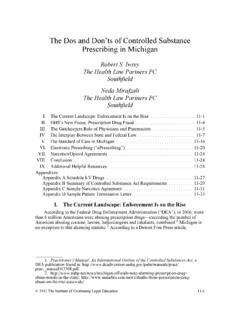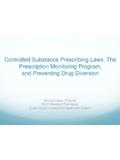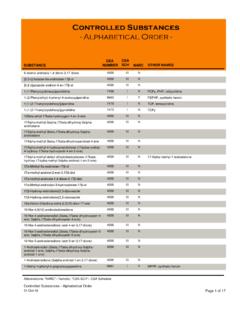Transcription of DISPENSING REQUIREMENTS FOR CONTROLLED …
1 University of Tennessee Advanced Studies inPharmacy n245 ABSTRACTThe DISPENSING of CONTROLLED substances incompliance with federal regulations is a functionthat is critical to the day-to-day activities of phar-macists, and as such, this article reviews the majorDrug Enforcement Administration REQUIREMENTS inregard to processing and DISPENSING Schedule IIthrough V prescriptions. Regulations on ScheduleII prescriptions are relatively stringent, with refillsbeing prohibited and verbal orders permitted onlyin emergency situations and with a provision thata written prescription is sent to the pharmacy with-in 7 days of the verbal order. Regulations forSchedule III, IV, and V prescriptions are morelenient, because prescriptions may be communi-cated orally or by facsimile to the pharmacist innonemergency situations, and up to 5 refills with-in 6 months of the date written on the script areallowed. Also discussed are regulations pertain-ing to electronic CONTROLLED substance prescrip-tions, changes to the face of a controlledsubstance prescription, and central fill pharma-cies.
2 REQUIREMENTS for processing of scheduledprescriptions (eg, drug name, strength, dosageform, quantity prescribed, directions for use, andnumber of refills) and labels affixed to dispensedmedications (eg, pharmacy name and address,prescription number, date of initial DISPENSING ,and US Food and Drug Administration warninglabel prohibiting transfer of the script) are very specific. Assessing legitimate medical purpose ofa scheduled prescription is a major responsibilityfor pharmacists, and in this regard, several tech-niques that drug-seeking individuals may use inobtaining CONTROLLED substances are described. (Adv Stud ;5(8):245-249)Many federal and state regulations governthe distribution of CONTROLLED sub-stances. Although most pharmacistsabide by these laws, a review of themajor aspects of these regulations may minimizeuncertainties that arise in the day-to-day DISPENSING ofcontrolled substances and may, ultimately, improvecompliance with the CONTROLLED Substances Act(CSA).
3 This article includes a summation, from theUS Drug Enforcement Administration (DEA), of thefederal REQUIREMENTS for pharmacist DISPENSING of con-trolled and drug products under the jurisdiction ofthe CSA are divided into 5 schedules, with agents inSchedules II through V categories having an acceptedmedical use in the United States. For all CONTROLLED sub-stance prescriptions, the pharmacist must make certainthat the prescription is dated and signed on the datewhen issued. Furthermore, the prescription mustinclude the patient s full name and address, as well asthe practitioner s name, address, and registration law requires the prescription to include thedrug name, strength, dosage form, quantity prescribed,directions for use, and number of situationsin which an oral prescription is not permitted, the pre-scription must be written in ink or indelible pencil, orit must be typewritten and signed by the FORSCHEDULEII SUBSTANCESS chedule II substances require a written prescriptionthat must be signed by the practitioner.
4 Although manystates have enacted time frames under which ScheduleII substance prescriptions may be filled, federal law doesnot place a time limit under which these prescriptionsmust be filled after being signed by the practitioner, nordoes it place quantity limits on any , it is imperative for the pharmacist to use pro-fessional judgment in determining whether the pre-scription is still needed by the patient (eg, a narcoticprescription filled several weeks after being written). REVIEWDISPENSING REQUIREMENTS FOR CONTROLLED SUBSTANCES Alan R. Spies, RPh, JD, MBA, PhD**Assistant Professor of Pharmacy Administration,SouthwesternOklahoma State University, College ofPharmacy, Weatherford, correspondence to: Alan R. Spies, RPh, JD,MBA, PhD, Assistant Professor of Pharmacy Administration,Southwestern Oklahoma State University, College ofPharmacy, 100 Campus Drive, Weatherford, OK : 5, No. 8nNovember 2008 REVIEWEMERGENCYDISPENSING OF ASCHEDULEII SUBSTANCEFor Schedule II substances, an oral order is onlypermitted in emergencies, which include situations inwhich immediate administration of the drug is neces-sary for proper treatment of the intended ultimateuser, when no alternative treatment is available(including a non-Schedule II substance), and when itis not possible for the prescriber to provide a writtenprescription at that , in the pharmacist s pro-fessional judgment, a true emergency situation arises,a practitioner may telephone a Schedule II prescrip-tion to the pharmacy, and the pharmacist may dis-pense the prescription, provided that:1.
5 The drug prescribed and dispensed mustbe limited to the amount needed to treatthe patient during the emergency or DISPENSING beyond the emer-gency period must be pursuant to a writtenprescription The prescription order must be immediate-ly reduced to writing by the pharmacistand must contain all information, exceptfor the prescribing practitioner s If the prescriber is not known to the phar-macist, the pharmacist must make a rea-sonable effort to verify that the phoneauthorization came from a valid practition-er by verifying the practitioner s telephonenumber with that listed in the directoryand by making other good faith efforts toinsure proper limited situations, a pharmacist mustreceive, within 7 days, a written and signed prescrip-tion from the practitioner for the CONTROLLED substancewith Authorization for Emergency DISPENSING writ-ten on its receipt, the DISPENSING pharma-cist must attach this written prescription to theoriginal oral prescription.
6 The pharmacist must notifythe nearest DEA Diversion Field Office if the writtenprescription has not been received within 7 days; how-ever, the pharmacist should remind the practitionerabout the prescription before calling the FORSCHEDULEII SUBSTANCESA pharmacist may fill a faxed Schedule II prescrip-tion, provided that the original prescription is presentedto the pharmacist and verified against the facsimile atthe time of actual DISPENSING . The DEA regulations pro-vide 3 situations in which a facsimile prescription for aSchedule II CONTROLLED substance can serve as the origi-nal prescription for DISPENSING . These 3 situations areprovided in the accompanying Pharmacist Checklist. PRE-ANDPOST-DATING OFSCHEDULEII PRESCRIPTIONSThe DEA released a final rule amending currentregulations to allow practitioners to provide individualpatients with multiple prescriptions for the sameSchedule II CONTROLLED substance (Table 1).2 The pre-scriptions must be filled sequentially so that the com-bined effect allows a patient to receive, over time, a90-day supply of that CONTROLLED substance.
7 A pharma-cist may not fill a prescription for a Schedule II con-trolled substance before the date noted on theprescription. Also, all prescriptions issued as multipleprescriptions must be dated and signed on the date ofissuance (ie, the same date of issuance must be on eachprescription). The final rule became effective onDecember 19, FORSCHEDULEIII V SUBSTANCESA prescription issued by a practitioner for ScheduleIII, IV, and V substances may be communicated eitherorally, in writing, or by facsimile to the pharmacist, andit may be refilled if authorized on the prescription and ifthe pharmacist determines the refills to be Schedule II prescriptions may not berefilled, Schedule III and IV prescriptions may berefilled if authorized on the prescription. However, theprescription may only be refilled up to 5 times within 6months after the date written on the prescription. After5 refills or after 6 months (whichever occurs first), a newprescription is required.
8 Schedule V prescriptions maybe refilled as authorized on the prescription and, underfederal law, Schedule V refills have less stringent require-ments. When a prescription for any CONTROLLED sub-stance in Schedule III, IV, or V is refilled, informationthat must be entered on the back of the prescriptionincludes the DISPENSING pharmacist s initials, the date onwhich the prescription was refilled, and the amount ofdrug dispensed on that refill. If the pharmacist only ini-tials and dates the back of the prescription, it will beassumed that the pharmacist dispensed a refill for thefull face amount of the DEA regula-tions provide that as an alternative to recording refillinformation on the back of a prescription, an automat-ed data processing system may be used for the storageand retrieval of refill information for prescription ordersUniversity of Tennessee Advanced Studies inPharmacy n247 REVIEWif certain conditions are fulfilled.
9 These conditions areprovided in the Pharmacist Checklist. TRANSFER OFPRESCRIPTIONINFORMATIONThe DEA permits the transfer between pharmaciesof original prescription information for Schedules III,IV, and V CONTROLLED substances for the purpose ofrefills on a 1-time basis, if permissible under state that share an online database containinginformation required for a valid prescription (such asin chain pharmacies) may transfer up to the maxi-mum refills permitted by law and the prescriber the CSA, Electronic Prescriptions forControlled Substances (EPCS) II through V are notconsidered valid prescriptions and, therefore, it is ille-gal to fill them. As such, a pharmacist who receives anEPCS should call the practitioner to obtain a verbalorder for the medication (or written order if aSchedule II medication). But in light of the enactmentof the Medicare Prescription Drug Improvement andModernization Act, the DEA is addressing this issuewith a proposed rule summarized in the verification of a CONTROLLED substance pre-scription, the pharmacist is permitted to make infor-mation-related changes (eg, adding or changing thepatient s address) provided by the patient or script bear-er.
10 However, the majority of other changes (ie, dosageform, drug strength, drugquantity, directions for use,and issue date) can be made only after consultationwith, and agreement of, the prescribing consultations and corresponding changes shouldbe noted on the prescription, as well as on the patient smedical record. The pharmacist is never permitted tomake changes to the patient s name, CONTROLLED sub-stance prescribed (except for generic substitution per-mitted by state law), or the prescriber s FORSCHEDULEII V SUBSTANCESP harmacists DISPENSING a prescription for a con-trolled substance must affix to the container a labelshowing the pharmacy name and address, the serial(prescription) number, date of initial DISPENSING , nameof the patient, name of the prescribing practitioner,Table 1. Key Provisions of the DEA Final RuleRegarding the Issuance of Multiple PrescriptionsDEA = US Drug Enforcement with permission from American Pharmacists Association (APhA).






